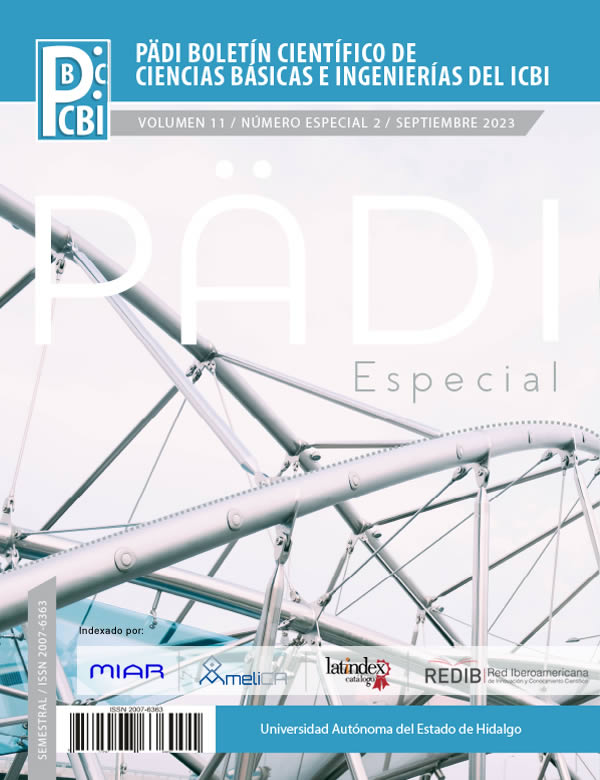Visual servoing controller for a commercial drone: comparison study
Abstract
Visual controllers have been very useful in robotics in recent years. Allowing a robot to visually perceive its environment enables it to interact and make decisions based on previously defined tasks. The easy acquisition of cameras, aerial vehicles, or commercial drones has allowed to research with them. A very useful tool for creating the link between the robot and its peripherals is the Robotic Operation System (ROS) software. Employing those topics previously mentioned, experimental results of a comparison of classical visual controllers are presented using a Tello drone, showing that each controller has its own behavior related to the space where the task is performed.
Downloads
References
Benhimane, S. y Malis, E. (2007). Homography-based 2d visual tracking and servoing. The International Journal of Robotics Research, 26(7):661–676.
Caldas, K. A. Q., Benevides, J. R. S., Inoue, R. S., y Terra, M. H. (2022). Autonomous robust navigation system for mav based on monocular cameras. En 2022 INTERNATIONAL CONFERENCE ON UNMANNED AIRCRAFT SYSTEMS (ICUAS), International Conference on Unmanned Aircraft Systems, pp. 1343–1349. International Conference on Unmanned Aircraft Systems (ICUAS), Dubrovnik, CROATIA, JUN 21-24, 2022.
Chaumette, F. y Hutchinson, S. (2006). Visual servo control, part i: Basic approaches. IEEE Robotics and Automation Magazine, 13(4):82–90.
Chaumette, F. y Hutchinson, S. (2007). Visual servo control, part ii: Advanced approaches. IEEE Robotics and Automation Magazine, 14(1):109–118.
Chen, J.-W., Kao, C.-Y., y Lin, Y.-L. (2006). Introduction to h.264 advanced video coding. volumen 2006.
Corke, P. I. y Hutchinson, S. A. (2001). A new partitioned approach to imagebased visual servo control. IEEE Trans. on Robotics and Automation, 17(4):507–515.
Garrido-Jurado, S., Muñoz-Salinas, R., Madrid-Cuevas, F., y Marín-Jiménez, M. (2014). Automatic generation and detection of highly reliable fiducial markers under occlusion. Pattern Recognition, 47(6):2280–2292. ArUco library version 3.2.0.
Ghaffari, M. y Hall, E. L. (2004). Robotics and nature: from primitive creatures to human intelligence. En Casasent, D. P., Hall, E. L., y Roning, J., editores, Intelligent Robots and Computer Vision XXII: Algorithms, Techniques, and Active Vision, volumen 5608, pp. 169 – 176. International Society for Optics and Photonics, SPIE.
Hussein, A., Al-Kaff, A., de la Escalera, A., y Armingol, J. M. (2015). Autonomous indoor navigation of low-cost quadcopters. En 2015 IEEE International Conference on Service Operations And Logistics, And Informatics (SOLI), pp. 133–138.
Intel Corporation and Willow Garage Inc. (2021). Opencv library. https: //opencv.org/.
Lee, M.-F. R. y Yusuf, S. H. (2022). Mobile robot navigation using deep reinforcement learning. Processes, 10(12).
Lin, H.-Y. y Peng, X.-Z. (2021). Autonomous quadrotor navigation with vision based obstacle avoidance and path planning. IEEE ACCESS, 9:102450–102459.
Lin, J., Miao, Z., Zhong, H., Peng, W., Wang, Y., y Fierro, R. (2021). Adaptive image-based leader-follower formation control of mobile robots with visibility constraints. IEEE TRANSACTIONS ON INDUSTRIAL ELECTRONICS, 68(7):6010–6019.
Machkour, Z., Ortiz-Arroyo, D., y Durdevic, P. (2022). Classical and deep learning based visual servoing systems: a survey on state of the art. JOURNAL OF INTELLIGENT & ROBOTIC SYSTEMS, 104(1).
Malis, E., Chaumette, F., y Boudet, S. (1999). 2½d visual servoing. Robotics and Automation, IEEE Transactions on, 15:238 – 250.
Marchand, E., Spindler, F., y Chaumette, F. (2005). Visp for visual servoing: a generic software platform with a wide class of robot control skills. IEEE Robotics and Automation Magazine, 12(4):40–52.
Nguyen, M. T., Truong, L. H., y Le, T. T. (2021). Video surveillance processing algorithms utilizing artificial intelligent (ai) for unmanned autonomous vehicles (uavs). MethodsX, 8:101472.
Stanford Artificial Intelligence Laboratory et al. (2018). Robotic operating system.
Parisi, E. I., Suma, M., Gülec¸ Korumaz, A., Rosina, E., y Tucci, G. (2019). Aerial platforms (uav) surveys in the vis and tir range. applications on archaeology and agriculture. The International Archives of the Photogrammetry, Remote Sensing and Spatial Information Sciences, XLII-2/W11:945–952.
Pestana, J., Sanchez-Lopez, J. L., Campoy, P., y Saripalli, S. (2013). Vision based gps-denied object tracking and following for unmanned aerial vehicles. En 2013 IEEE International Symposium on Safety, Security, and Rescue Robotics (SSRR), pp. 1–6.
Rubio, F., Valero, F., y Llopis-Albert, C. (2019). A review of mobile robots: Concepts, methods, theoretical framework, and applications. International Journal of Advanced Robotic Systems, 16(2):1729881419839596.
Tong, Q., Kim, J., Choi, K., y Lee, Y. S. (2015). High efficient hevc (h.265) codec design for mobile applications. En 2015 International SoC Design Conference (ISOCC), pp. 165–166.
Toro-Arcila, C. A., Becerra, H. M., y Arechavaleta, G. (2023). Visual path following with obstacle avoidance for quadcopters in indoor environments. CONTROL ENGINEERING PRACTICE, 135.
Copyright (c) 2023 Pablo Alonso Ochoa-Salinas, América Berenice Morales-Díaz, Héctor Manuel Pérez-Villeda, Rodolfo de Jesús Villalobos-Salazar

This work is licensed under a Creative Commons Attribution-NonCommercial-NoDerivatives 4.0 International License.













